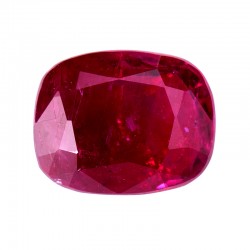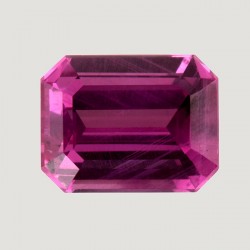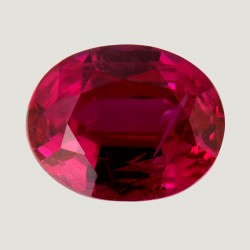
Red is the colour of love. It radiates warmth and a strong sense of vitality. And red is also the colour of the ruby, the king of the gemstones. In the fascinating world of gemstones, the ruby is the undisputed ruler.
For thousands of years, the ruby has been considered one of the most valuable gemstones on Earth. It has everything a precious stone should have: magnificent colour, excellent hardness and outstanding brilliance. In addition to that, it is an extremely rare gemstone, especially in its finer qualities.
For a long time India was regarded as the ruby's classical country of origin. In the major works of Indian literature, a rich store of knowledge about gemstones has been handed down over a period of more than two thousand years. The term 'corundum', which we use today, is derived from the Sanskrit word 'kuruvinda'. The Sanskrit word for ruby is 'ratnaraj', which means something like 'king of the gemstones'. And it was a royal welcome indeed which used to be prepared for it. Whenever a particularly beautiful ruby crystal was found, the ruler sent high dignitaries out to meet the precious gemstone and welcome it in appropriate style. Today, rubies still decorate the insignia of many royal households.
Some rubies display a wonderful silky shine, the so-called 'silk' of the ruby. This phenomenon is caused by very fine needles of rutile. And now and then one of the rare star rubies is found. Here too, the mineral rutile is involved: having formed a star-shaped deposit within the ruby, it causes a captivating light effect known by the experts as asterism. If rubies of this kind are cut as half-dome shaped cabochons, the result is a six-spoked star which seems to glide magically across the surface of the stone when the latter is moved. Star rubies are precious rarities. Their value depends on the beauty and attractiveness of the colour and, though only to a lesser extent, on their transparency.
The most important thing about this precious stone is its colour. It was not for no reason that the name 'ruby' was derived from the Latin word 'rubens', meaning 'red'. The red of the ruby is incomparable: warm and fiery. Two magical elements are associated with the symbolism of this colour: fire and blood, implying warmth and life for mankind. So ruby-red is not just any old colour, no, it is absolutely undiluted, hot, passionate, powerful colour. Like no other gemstone, the ruby is the perfect way to express powerful feelings. Instead of symbolising a calm, controlled affection, a ring set with a precious ruby bears witness to that passionate, unbridled love that people can feel for each other.
Ruby deposits are located in Burma, Vietnam, India, Northern Pakistan in the Hunza Valley, Kashmir, Tajikistan, Laos, Nepal, and Afghanistan, and in many parts of Africa.
As we have said, colour is a ruby's most important feature. Its transparency is only of secondary importance. So inclusions do not impair the quality of a ruby unless they decrease the transparency of the stone or are located right in the centre of its table. On the contrary: inclusions within a ruby could be said to be its 'fingerprint', a statement of its individuality and, at the same time, proof of its genuineness and natural origin. befitting the 'king of the gemstones'.
However, a really perfect ruby is as rare as perfect love. If you do come across it, it will cost a small fortune. But when you have found 'your' ruby, don't hesitate: hang on to it!
R.M.Shah Ltd.
Knowledge, Integrity & Service.


-250x250.jpg)


CBNH-Ov.Ruby-cts0.65-250x250.jpg)
